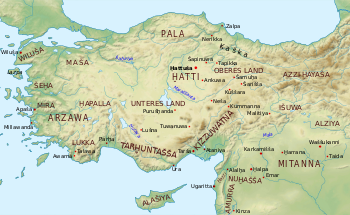أرض نهر شخا
Seha River Land | |
|---|---|
 Location of the Seha River Land | |
| المكانة | Vassal state of the Hittite Empire |
| العاصمة | Kaymakçı Tepe (hypothesized) |
| الحكومة | Kingdom |
• c. 1300 BC | Manapa-Tarhunta |
| الحقبة التاريخية | Bronze Age |
| Today part of | Aegean Region, Turkey |
The Seha River Land was a kingdom in Western Anatolia in the Late Bronze Age known from Hittite texts. Part of Arzawa, it was located north of Mira and south of Wilusa, and at one point controlled the island of Lazpa.[1]
التاريخ
The Seha River Land was a reluctant vassal state of the Hittite Empire, and much of its known history was turbulent. The Annals of Mursili II recount how the Hittite king Mursili II consolidated power over the region around 1320 BC, crushing a revolt in which the Seha River Land partipated. According to Mursili, he besieged the Seha River Land's capital and was on the verge of destroying it when he accepted a last minute mercy plea from King Manapa-Tarhunta's own mother, delivered right outside the city gates. A treaty was drawn up which confirmed Manapa-Tarhunta's status as a Hittite vassal, though he once again had to plead for mercy in the Manapa-Tarhunta letter, this time because of his failure to provide Mursili with timely military support.[2][1]
Manapa-Tarhunta was eventually deposed and replaced by someone named Masturi, who may have been his son. Masturi's ascent to the throne was supported by Mursili's successor Muwatalli II, and the kingdom appears to have remained loyal to the Hittites under his rule. However, it once again revolted after Masturi was himself deposed by someone named Tarhunta-Radu, seemingly with the support of the Ahhiyawa. This revolt was crushed by the Hittite king Tudhaliya IV, after which a descendant of Manapa-Tarhunta was reinstalled on the Seha River Land's throne.[2][1]
الموقع
The Seha River itself is generally identified with the Bakırçay River or the Gediz River, but the kingdom's precise location has not been conclusively identified.[3] The leading candidate for the site of its capital is Kaymakçı Tepe near the Gediz River, where excavations since 2014 have revealed a major Bronze Age settlement whose citadel is more than four times larger than that of contemporary Troy.[4][5]
Max Gander suggested that Seha River Land should be located further to the south of where it is conventionally seen. Thus it could be located south of Ephesus, and closer to the valley of Meander River. Such a location was generally considered in older scholarship, according to him.[6]
انظر أيضاً
المراجع
- ^ أ ب ت Bryce, Trevor (2011). "The Late Bronze Age in the West and the Aegean". In Steadman, Sharon; McMahon, Gregory (eds.). The Oxford Handbook of Ancient Anatolia. Oxford University Press. pp.366-367. doi:10.1093/oxfordhb/9780195376142.013.0015.
- ^ أ ب Beckman, Gary; Bryce, Trevor; Cline, Eric (2012). The Ahhiyawa Texts. Brill. pp. 45–49, 143–144, 156–157. ISBN 978-1589832688.
- ^ Bryce, Trevor (2005). The Trojans and their Neighbours. Taylor & Francis. p. 86. ISBN 978-0-415-34959-8.
- ^ Roosevelt, Christopher; Luke, Christina (2017). "The story of a forgotten kingdom? Survey archaeology and the historical geography of central western Anatolia in the second millennium BC" (PDF). European Journal of Archaeology. 20 (1): 120–147. doi:10.1017/eaa.2016.2.
- ^ Meriç, Recep (2020). "The Arzawa lands. The historical geography of İzmir and its environs during Late Bronze Age in the light of new archaeological research". TÜBA-AR Türkiye Bilimler Akademisi Arkeoloji Dergisi. 27. doi:10.22520/tubaar.2020.27.009.
- ^ Max Gander (2014), An Alternative View on the Location of Arzawa. Hittitology today: Studies on Hittite and Neo-Hittite Anatolia in Honor of Emmanuel Laroche’s 100th Birthday. Alice Mouton, ed. p. 163-190